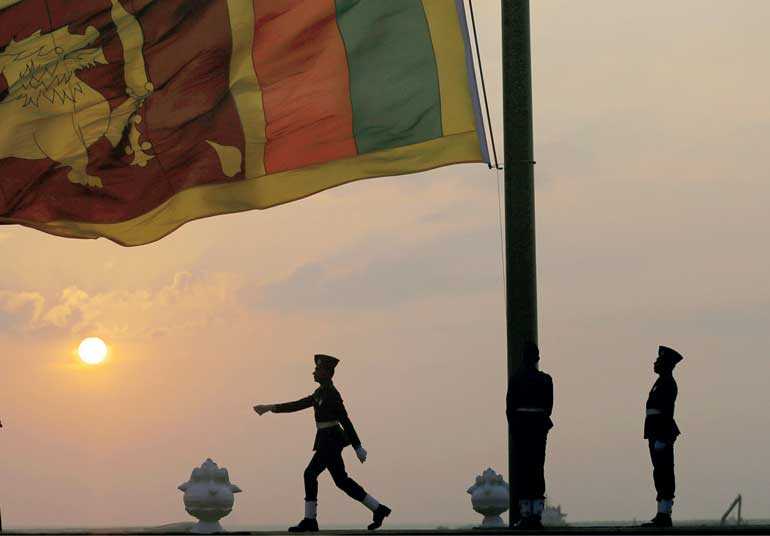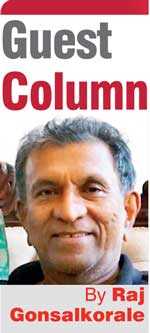Monday Dec 29, 2025
Monday Dec 29, 2025
Monday, 4 February 2019 00:00 - - {{hitsCtrl.values.hits}}

Sri Lanka (then Ceylon) became free from British colonial rule on 4 February 1948. Many opine that ours was more of an after effect of independence granted to India rather than a consequence of a struggle for independence. Be that as it may, we celebrate our 71st year of independence on 4 February 2019.
But, are we really free?
Are we free of communal disharmony? Are we free from discrimination? Are we free from gender inequality? Are we free from poverty? Are we free from food insecurity? Are we free from debt? The list can be endless.
Of course some strides have been made and we can be proud that we have a very high literacy rate and good health indicators. We are the envy of other developing countries in regard to health and education. Our GDP at times had reached a height of 7% (2015) and last year we were voted as the world’s best tourist destination. The list of positives too is long.
We celebrate our 71st year of independence on 4 February 2019. But, are we really free? Are we free of communal disharmony? Are we free from discrimination? Are we free from gender inequality? Are we free from poverty? Are we free from food insecurity? Are we free from debt? The list can be endless
However, on this momentous day, Sri Lankans must consider whether they are really free and independent or whether they are in fact “in dependence”.
In regard to the economy, an article titled ‘Sri Lanka seeks regional bailout as balance of payments crisis looms’ published in the Nikkei Asian Review on 21 January, written by Asia Regional Correspondent Marwaan Macan-Markar, paints a very dire picture. Some excerpts are quoted here:
“Sri Lanka’s foreign exchange reserves were down to $6.9 billion at the end of last year, when investors were spooked by political turmoil that brought down the island nation’s ratings. Last week, CBSL revealed that Sri Lanka has paid back a $1 billion international sovereign bond by dipping into foreign exchange reserves after attempts to raise funds from the international bond market failed. There is a record debt of $ 5.9 billion that must be met by the end of 2019, and foreign reserves will be severely depleted if Sri Lanka has to carry on in this way. The $87 billion economy is saddled with unprecedented debt. Banking sources in Colombo estimate maturing loans between 2019 and 2022 to be around $20.9 billion.
“Chinese banks have financed a number of major infrastructure projects in recent years. Verite Research, a Colombo-based think tank, estimates that China accounts for nearly 15% of Sri Lanka’s external debt, which was estimated to be around $53.1 billion at the end of 2018.
“The largest part of the country’s foreign loan portfolio is in dollar-denominated international sovereign bonds, estimated to be nearly 50%, followed by debts to Japan, the Asian Development Bank and the World Bank.
“Indrajit Coomaraswamy, the Governor of Sri Lanka’s Central Bank, told a public forum in Colombo that both the RBI and the Bank of China are considering plans to scale up their respective offers to $1 billion each. ‘Sri Lanka’s friends, the two regional giants, have stepped up to support us in this time when we were pushed into a rather difficult corner,’ he told the meeting hosted by the Ceylon Chamber of Commerce.”
According to this, 53.7 $ billion out of our total economy of $87 billion or 61.7% of it is external debt, with $5.9 billion due for repayment in 2019. The writer is no economist, hence unable to see how this repayment can be made unless we borrow more to pay for existing borrowings or our productivity and foreign exchange earnings goes up miraculously and we pay our loans with our own money. Alternatively, recalling Dr. N.M. Perera’s prescription, we tighten our belts hard and save money!
53.7 $ billion out of our total economy of $87 billion or 61.7% of it is external debt, with $5.9 billion due for repayment in 2019. The writer is no economist, hence unable to see how this repayment can be made unless we borrow more to pay for existing borrowings or our productivity and foreign exchange earnings goes up miraculously and we pay our loans with our own money. Alternatively, recalling Dr. N.M. Perera’s prescription, we tighten our belts hard and save money! We could do this, but it requires honesty and guts
We could do this, but it requires honesty and guts. We could stop imports of all motor vehicles including, very importantly, those for Members of Parliament say for three years. We could thereafter standardise vehicles for politicians and ban the import of any vehicle over an engine capacity of say over 2,500 CC. We could close down the bleeding dinosaur SriLankan Airlines or operate it only as a regional airline flying to India, Singapore, China, Thailand and the Middle East. We could stop subsidising loss-making Government corporations so that they operate as breakeven entities as a minimum.
We could stop food imports progressively and enforce a ban on imports within a reasonable timeframe. We could go after tax dodgers and bring in harsh penalties for those are caught. There is no doubt that the country is flushed with black money from bribes and commissions and there is no accountability.
If we wish to be serious, we can find ways and means to make people accountable. We could provide incentives for selected industries that are export oriented and import substitution oriented, and for agriculture and agriculture linked industries.
In regard to the most important indicator that determines our survival as a “free” nation, we are indeed in dire straits and in dependence to China, India, the IMF and other lenders. Of course we can celebrate with all the pomp and pageantry and continue pretending as we are accustomed to doing as a habit. This dependence corners us at every turn. Sri Lanka is today hemmed in by our lenders
Can we get out of the mess we are in? Of course we can. But, perhaps only our politicians could also be banned for three years!
Sri Lanka’s foreign exchange earnings primarily comes from tourism, remittances from those working overseas and of course the traditional tea and rubber exports.
While garment exports bring in foreign currency as well, the net earnings from this industry may not be contributing much to the bottom line as we are primarily a processing location where most, if not all inputs are imported.
Politicians of course would blame each other for this crisis and accuse each other as to who borrowed, how much, and for what purpose. Leaving such a political debate out of this, it is clear that we are negotiating with China, India and the IMF to secure more loans to pay off existing loans and consequently become more indebted as a country. So, in regard to the most important indicator that determines our survival as a “free” nation, we are indeed in dire straits and in dependence to China, India, the IMF and other lenders. Of course we can celebrate with all the pomp and pageantry and continue pretending as we are accustomed to doing as a habit.
This dependence corners us at every turn. As King Dutugemunu as a Prince had reportedly told his father why he was curled up in bed and why he needed to go to battle to free the country, Sri Lanka is today hemmed in by our lenders to the East, North and West. There is nothing but the sea to the South.
Sri Lanka is hardly free in any international economic or political forums and has to make compromises that are disadvantageous to the country in the longer term. A good example was the co-sponsoring of the last UNHRC resolution and placing the noose around our own neck.
Should we celebrate independence as if there is no crisis? Or should we accept the reality that we are in dependence and are drowning in debt and resolve to do something about it?